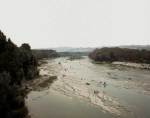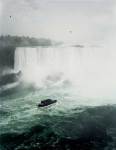Andreas Gursky has an implacable, even way of looking at the world. Human drama is leached from his photographs to leave stubbornly plain pictures, reflecting a perspective that he has described as ‘extraterrestrial’. His topographical approach, however, is far from anonymous. Now one of the world’s most successful photographers, Gursky’s curiously detached worldview, often presented on a scale associated with grand history paintings, is well known. The Rhine II (1999) currently holds the record for the most expensive photograph ever sold at auction.
Installation view, Andreas Gursky, ‘Early Landscapes’, Sprüth Magers London, 15 April–21 June, 2014. Photography © Stephen White

This impersonal style is nowhere more obvious than in his early photographs of landscapes, a selection of which can currently be seen at Sprüth Magers. Dating from 1984 to 1994, the photographs are of landscapes across the world, all recorded with the same apparent impassivity. In Niagara Falls (1989), even the thundering waterfalls appear to be silenced, the lone tourist boat in the foreground an object of curiosity that carries no particular story.
The deliberate blandness of these early photographs is courageous, and a reminder of how important Gursky has been to establishing photography as an independent art form. With a show of new work opening at White Cube, Bermondsey this week, the show is a timely reminder of the unassuming outlook that has distinguished him from the beginning.
‘Andreas Gursky: Early Landscapes’ is at Sprüth Magers Gallery, London, until 21 June.
‘Andreas Gursky’ is at White Cube, Bermondsey, from 30 April–6 July.





